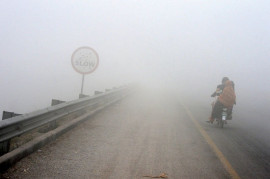
Imagine a whole lake fishing down a mountain at once, carrying ice and rock within it. This is the reality of the lesser known threat in the high mountains, which grows more common and occurs as the climate changes; the Glacial Lake Outburst Floods (GLOFs). Global temperatures are rising, and glaciers are melting worldwide. The melting creates feeble, dammed glacial lakes that can violently burst, resulting in floods that devastate downstream communities. Many people lie in the shadows of glaciers, especially in the Andes, Swiss Alps, and in North Pakistan, our very own Himalayas-Hindukush-and Karakoram. Together they form the largest reservoir of ice outside the polar region.
Laws for Glacier Protection (GPLs) have been developed in Chile and Argentina to protect glacierised regions from the detrimental consequences of mining activities. In the existing legal environment, regulations may get prolonged impacting downstream populations and socioeconomic assets and impeding climate change adaptation plans. Both rules were written with receding and stationary glaciers in mind, ignoring the possibilities of glacial advance, fast glacier retreat, and the issues that come with it. Pakistan needs to focus on developing legislation on glaciers. Our parliamentarians must be schooled and sensitised over our melting glaciers, especially in light of rising global temperatures and booming eco-tourism in Pakistan.
These occurrences are sudden and unpredictable, with little or no warning when a dammed glacier lake bursts. Because the natural dams that retain glacial lakes are fragile, a little crack can soon grow into a catastrophic hole. Lakes are usually blocked by ice or a moraine, a mound of rocks and dirt left behind. In either situation, the rushing water transports dam material and continuously expands the crack. This implies that even little disruptions, such as heavy rainfall or a splash from a falling block of ice, might cause a significant flood. While a glacier flood usually destroys a moraine dam, ice dams often close up and break again. These ice-dammed lakes may even drain a refill cyclically.
Scientists are attempting to examine these glaciers for eminent floods and offer time to prepare for the deluge, which is a complicated occurrence to anticipate. Other experts approach glacial lakes in different ways. The stakes are rising as our changing climate raises the possibility of glacier floods. Climate change is affecting the stability of glacial mountains. These changes serve as a reminder of how people have touched nature, as well as how nature will affect us in the future. According to the latest National Disaster Management Authority (NDMA) report, flooding in Pakistan has been caused by record monsoon rains and glacier melt in the north, affecting 33 million people and killing at least 1,325, including 466 children with 636,940 displaced.
Pakistan is responsible for less than 1% of global greenhouse gas emissions yet is the eighth-most susceptible country to climate change. Rather than the low elevation plains, Pakistan’s northern highlands, which house the Himalayan-Karakoram-Hindukush glaciers, have held more heat than the world average during the last 100 years. The climate in the high mountains was much warmer than the national average. With decreasing rainfall and rising temperatures in Pakistan’s regions, it may be in the best interests of local communities to use glacial lakes as reservoirs for drinking water or subsistence agriculture, especially since demand for irrigation water is expected to rise as a result of global warming.
The snowline has been quickly migrating upwards, allowing biodiversity to move and precipitation in the form of rainfall rather than snowfall. The rapid rise in temperature regime has accelerated the melting of low-elevation glaciers. As a result, the creation of new glacial lakes and the extension of existing lakes have raised the risk of outburst floods. The increased risk of GLOFs and significant water cycle variability necessitate a coordinated global and regional approach to replicating knowledge, experience and success stories from one location to another. Pakistan needs the global community to mobilise resources; and concerned organisations should expand their ability to raise the density of their glacier/lake monitoring network, refine monitoring procedures, use novel research methodologies, establish robust infrastructure, and develop an early warning system for a comprehensive disaster risk reduction.
Omissions in previous and prospective GPLs can lead to social and environmental problems. Such conflicts can arise when intervention is required for glacial lakes, such as dam reinforcement infrastructure or glacial lake syphoning, or when supraglacial or subglacial lakes must be drained in arid regions where competition for water resources is fierce. Because authorising glacier intervention to control glacial risks might be used as a backdoor to meddle in the glacial landscape solely for economic interests, Pakistan is home to eco-tourism, be it mountaineering or hiking our Himalayas-Hindukush-and Karakoram ranges. GPLs should be clear about the interventions to preserve economic projects established in glacier regions.
Published in The Express Tribune, September 22nd, 2022.
Like Opinion & Editorial on Facebook, follow @ETOpEd on Twitter to receive all updates on all our daily pieces.

















1734778885-0/Untitled-(10)1734778885-0-270x192.webp)

COMMENTS
Comments are moderated and generally will be posted if they are on-topic and not abusive.
For more information, please see our Comments FAQ